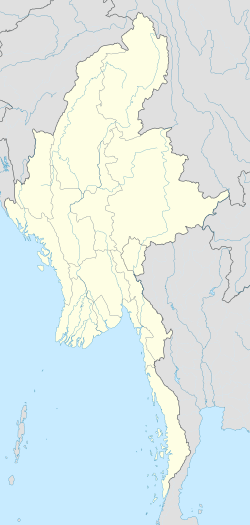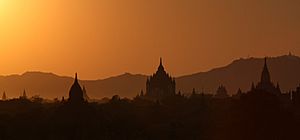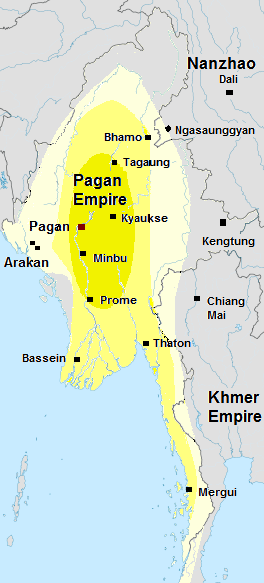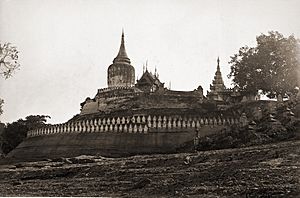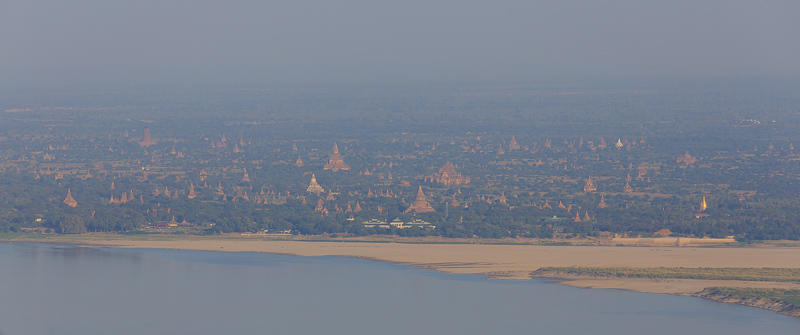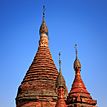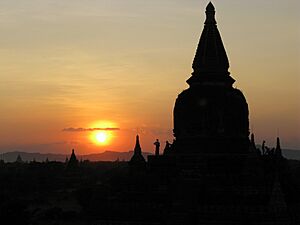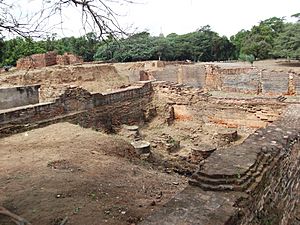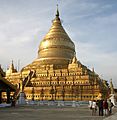Bagan facts for kids
Quick facts for kids
Bagan
ပုဂံ
Pagan
|
|
|---|---|
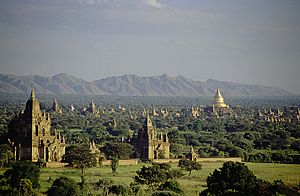
Temples and pagodas in Bagan
|
|
| Country | Myanmar |
| Region | Mandalay Region |
| Founded | mid-to-late 9th century |
| Area | |
| • Total | 104 km2 (40 sq mi) |
| Population | |
| • Ethnicities | Bamar people |
| • Religions | Theravada Buddhism |
| Time zone | UTC+6.30 (MST) |
| Website | |
| UNESCO World Heritage Site | |
| Official name | Bagan |
| Location | Mandalay Region, Myanmar |
| Criteria | Cultural: iii, iv, vi |
| Inscription | 2019 (43rd Session) |
| Area | 5,005.49 ha (12,368.8 acres) |
| Buffer zone | 18,146.83 ha (44,841.8 acres) |
Bagan (Burmese: ပုဂံ; MLCTS: pu.gam, IPA: [bəɡàɰ̃]), once known as Pagan, is an amazing ancient city in Myanmar. It's located in the Mandalay Region and is a special World Heritage Site recognized by UNESCO.
From the 9th to the 13th centuries, Bagan was the capital of the Pagan Kingdom. This was the first kingdom that united the areas that make up Myanmar today. During its busiest time, between the 11th and 13th centuries, people built over 10,000 Buddhist temples, pagodas, and monasteries in the Bagan plains. Today, more than 2,200 of these incredible temples and pagodas still stand.
The Bagan Archaeological Zone is a major attraction for tourists visiting Myanmar.
Contents
What's in a Name?
Bagan is the modern way to say the old Burmese word Pugan. Its classical name in the ancient language Pali was Arimaddanapura, which means "the City that Tramples on Enemies."
Because Bagan is in a very dry area, it also had other Pali names like Tattadesa ("parched land") and Tampadīpa ("bronzed country").
Bagan's Story
From Small Town to Great Kingdom (9th to 13th Centuries)
Ancient stories say Bagan was founded a very long time ago. It was fortified, or made stronger with defenses, in 849 by King Pyinbya. However, most historians believe Bagan was started in the mid-to-late 9th century by the Burmans. They had recently moved into the Irrawaddy valley. For a while, Bagan was just one of many small cities. But by the late 10th century, it started to become more powerful.
From 1044 to 1287, Bagan was the capital of the Pagan Empire. It was the main center for politics, money, and culture. Over 250 years, the kings and rich people of Bagan built more than 10,000 religious buildings. This included about 1,000 stupas, 10,000 small temples, and 3,000 monasteries. All of these were built in an area of just 104 km2 (40 sq mi)!
Bagan grew into a grand city. It became a place where people from all over came to study religion and other subjects. Scholars from India, Sri Lanka, and the Khmer Empire came to learn.
Religion was very important in Bagan. People practiced Theravada Buddhism, Mahayana Buddhism, and Tantric Buddhism. They also followed Hindu traditions and believed in local spirits called nat. While Theravada Buddhism became the most popular, other beliefs also continued to be important.
Most of Bagan's biggest buildings were constructed between 1150 and 1200. The city became very crowded with monuments around "Old Bagan." Later, new groups of buildings appeared further east.
Building all these temples created many jobs. People worked as brickmakers, masons, carpenters, and artists. Accountants and scribes were also needed to manage the temple properties. These jobs paid well, attracting many people to Bagan. People from different backgrounds and languages lived and worked there.
The Bagan Empire ended in 1287 because of repeated attacks by the Mongols. Some research suggests the Mongols might not have caused all the damage. It's possible that local leaders became very strong and Bagan lost its importance. Either way, Bagan became a small town and never regained its former glory.
Later Years (14th to 19th Centuries)
Bagan continued to be a place where people lived and visited for religious reasons. A few new religious buildings were still built until the mid-15th century. After that, new temple construction slowed down a lot. Only a few hundred temples were built between the 15th and 20th centuries.
People still visited Bagan, but they focused on only a few famous temples. These included the Ananda, the Shwezigon, and the Sulamani. Thousands of other temples were left alone and fell apart over time.
Some of the popular temples were repaired and added to by visitors. Many were repainted or given new Buddha statues. Later, during the Konbaung dynasty (1752–1885), there were more "systematic" renovations. However, these often changed the original designs and used different materials.
Modern Times (20th Century to Today)
Bagan is in an area where earthquakes happen often. Over 400 earthquakes were recorded between 1904 and 1975. A big earthquake hit on July 8, 1975. It damaged many temples, some very badly, like the Bupaya. Today, 2,229 temples and pagodas remain.
In the 1990s, the government tried to restore many damaged pagodas. They wanted Bagan to become a major tourist spot. However, many art experts and historians criticized these restorations. They said the repairs didn't follow the original styles and used modern materials. The government also built a golf course and a tall watchtower.
Even though there were many temples and old stone writings, Bagan was not named a UNESCO World Heritage Site until 2019. This was partly because of the controversial restorations.
On August 24, 2016, another large earthquake hit Bagan. It damaged nearly 400 temples. The Sulamani was badly hurt. The Bagan Archaeological Department started to survey and rebuild with help from UNESCO. Visitors were not allowed into 33 badly damaged temples.
Finally, on July 6, 2019, Bagan officially became a UNESCO World Heritage Site. This happened 24 years after it was first suggested! Bagan is now the second World Heritage Site in Myanmar. As part of this, the government promised to move hotels from the ancient zone to a special hotel area.
Today, Bagan is a very popular place for tourists in Myanmar.
Where is Bagan?
The Bagan Archaeological Zone is a large area about 13 km × 8 km (8.1 mi × 5.0 mi) wide. It includes "Old Bagan" in the middle, Nyaung U to the north, and New Bagan to the south. It's located on the Irrawaddy river in Upper Burma. Bagan is about 290 km (180 mi) southwest of Mandalay and 700 km (430 mi) north of Yangon.
Bagan's Weather
Bagan is in Myanmar's "Dry Zone." This area gets very little rain because it's protected by the Rakhine Yoma mountains.
| Climate data for Bagan | |||||||||||||
|---|---|---|---|---|---|---|---|---|---|---|---|---|---|
| Month | Jan | Feb | Mar | Apr | May | Jun | Jul | Aug | Sep | Oct | Nov | Dec | Year |
| Mean daily maximum °C (°F) | 32 (90) |
35 (95) |
36 (97) |
37 (99) |
33 (91) |
30 (86) |
30 (86) |
30 (86) |
30 (86) |
32 (90) |
32 (90) |
32 (90) |
32 (91) |
| Mean daily minimum °C (°F) | 18 (64) |
19 (66) |
22 (72) |
24 (75) |
25 (77) |
25 (77) |
24 (75) |
24 (75) |
24 (75) |
24 (75) |
22 (72) |
19 (66) |
23 (72) |
| Source: www.holidaycheck.com | |||||||||||||
| Climate data for Bagan | |||||||||||||
|---|---|---|---|---|---|---|---|---|---|---|---|---|---|
| Month | Jan | Feb | Mar | Apr | May | Jun | Jul | Aug | Sep | Oct | Nov | Dec | Year |
| Mean daily maximum °C (°F) | 28 (82) |
32 (90) |
36 (97) |
39 (102) |
38 (100) |
35 (95) |
33 (91) |
32 (90) |
32 (90) |
31 (88) |
29 (84) |
27 (81) |
33 (91) |
| Mean daily minimum °C (°F) | 16 (61) |
19 (66) |
24 (75) |
28 (82) |
29 (84) |
27 (81) |
26 (79) |
25 (77) |
25 (77) |
24 (75) |
20 (68) |
17 (63) |
23 (74) |
| Average rainfall mm (inches) | 5 (0.2) |
0.6 (0.02) |
2.6 (0.10) |
16.4 (0.65) |
49.6 (1.95) |
69.8 (2.75) |
126.7 (4.99) |
182 (7.2) |
152.4 (6.00) |
103.6 (4.08) |
25.5 (1.00) |
5.7 (0.22) |
739.9 (29.16) |
| Average rainy days | 2 | 1 | 2 | 9 | 14 | 21 | 26 | 28 | 24 | 20 | 6 | 2 | 155 |
| Source: www.weatheronline.com | |||||||||||||
City Views
Amazing Architecture
Bagan is famous not just for how many religious buildings it has, but also for their beautiful design. The art in Bagan's pagodas shows how skilled Myanmar's craftspeople were. Bagan temples generally fall into two main types: the solid stupa-style temple and the hollow gu-style temple.
Stupas (Solid Temples)
A stupa, also called a pagoda or chedi, is a large, solid building. It usually has a special chamber inside for relics. Bagan's stupas developed from older designs. These designs were inspired by stupas from India and Sri Lanka. The stupas in Bagan then became the models for all later Burmese stupas.
Originally, a stupa had a round, dome-like body. On top of this was a square box with a stone fence. A pole with several ceremonial umbrellas extended from the top. The shape of the stupa represents Mount Meru, a sacred mountain in Buddhist cosmology. The umbrellas symbolize the world's axis. The brickwork was often covered in stucco and decorated with carvings.
Over time, the design changed. The earliest Bagan stupas, like the Bupaya, were similar to older styles. By the 11th century, stupas became more bell-shaped. The umbrellas turned into a series of smaller rings stacked on top of each other, rising to a point. The top of the stupa changed from a box to a lotus bud shape, which then became the "banana bud" shape seen on most Burmese pagodas today.
Many pagodas had three or four rectangular terraces at their base. These often featured terra-cotta tiles showing stories from the Buddha's past lives, called jataka stories. The Shwezigon Pagoda and the Shwesandaw Pagoda are early examples of this bell-shaped style.
Gu Temples (Hollow Temples)
Unlike the solid stupas, the hollow gu-style temples were used for meditation and worship. Gu temples come in two main styles: "one-face" (one main entrance) and "four-face" (four main entrances). Some also have five faces or are a mix of styles. These temples became larger and grander during the Bagan period.
Cool Building Techniques
Even though Burmese temple designs came from other styles, the way they built vaulted ceilings seems to have been developed right in Bagan. The first vaulted temples in Bagan appeared in the 11th century. This was before vaulting became common in India. The brickwork in these buildings is incredibly perfect. Many of the huge structures survived the 1975 earthquake almost completely intact.
Another cool idea from Bagan is the Buddhist temple with a five-sided floor plan. This design came from mixing the one-face and four-face styles. The idea was to honor the Maitreya Buddha, who is believed to be the fifth Buddha of this era. The Dhammayazika and the Ngamyethna Pagoda are examples of this five-sided design.
Famous Places to See
| Name | Picture | Built | Sponsor(s) | Notes |
|---|---|---|---|---|
| Ananda Temple |  |
1105 | King Kyansittha | One of Bagan's most famous temples; 51 m (167 ft) tall. |
| Bupaya Pagoda |  |
c. 850 | King Pyu Saw Hti | In Pyu style; the original 9th-century pagoda was destroyed by the 1975 earthquake and rebuilt. |
| Dhammayangyi Temple |  |
1167–1170 | King Narathu | The largest of all temples in Bagan. |
| Dhammayazika Pagoda |  |
1196–1198 | King Sithu II | |
| Gawdawpalin Temple |  |
c. 1211–1235 | King Sithu II and King Htilominlo | |
| Gubyaukgyi Temple (Myinkaba) |  |
1113 | Prince Yazakumar | |
| Htilominlo Temple |  |
1218 | King Htilominlo | A 46 m (151 ft), 3-story temple. |
| Lawkananda Pagoda | 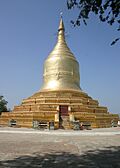 |
c. 1044–1077 | King Anawrahta | |
| Mahabodhi Temple |  |
c. 1218 | King Htilominlo | A smaller copy of the famous Mahabodhi Temple in Bodh Gaya, India. |
| Manuha Temple |  |
1067 | King Manuha | |
| Mingalazedi Pagoda |  |
1268–1274 | King Narathihapate | |
| Myazedi inscription | 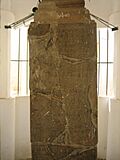 |
1112 | Prince Yazakumar | Called the "Rosetta Stone of Burma" because it has writings in four languages: Pyu, Old Mon, Old Burmese, and Pali. |
| Nathlaung Kyaung Temple |  |
c. 1044–1077 | A Hindu temple. | |
| Shwegugyi Temple |  |
1131 | King Sithu I | Known for its arched windows. |
| Shwesandaw Pagoda |  |
c. 1057 | King Anawrahta | 100 m (328 ft) tall without its spire; the tallest pagoda in Bagan. |
| Shwezigon Pagoda |  |
1102 | King Anawrahta and King Kyansittha | |
| Sulamani Temple |  |
1183 | King Sithu II | |
| Tharabha Gate |  |
c. 1020 | King Kunhsaw Kyaunghpyu and King Kyiso | The only part of the old city walls that still stands. |
| Thatbyinnyu Temple |  |
1150/51 | Sithu I | 66 m (217 ft); the tallest temple in Bagan. |
Old Bagan: The Walled City
The main part of Bagan, called "Old Bagan," is a 140-hectare area by the river. It's surrounded by three walls. A fourth wall might have been on the river side but was washed away. The river has definitely worn away parts of the city over time.
"Old Bagan" is actually a very small part of the whole 8,000-hectare area where monuments are found. This suggests that "Old Bagan" was likely the special area for the rulers and important people, not the entire city.
Museums
- The Bagan Archaeological Museum: This is the only museum in the Bagan Archaeological Zone. It has many rare items from the Bagan period. This includes the original Myazedi inscriptions, which are like the "Rosetta Stone" of Burma because they are written in four languages.
- Anawrahta's Palace: This palace was rebuilt in 2003 on the site of the old palace. However, the design of the new palace is mostly guessed, as there wasn't enough information about the original.
Getting Around Bagan
You can reach Bagan by plane, train, bus, car, or even by river boat!
By Air
Most international visitors fly to Bagan. The Nyaung U Airport is the main airport for the Bagan area. Several airlines have regular flights to Yangon (about 80 minutes) and Mandalay (about 30 minutes). The airport is close to Nyaung U, and it's about a 20-minute taxi ride to Bagan.
By Train
Bagan is connected to the Yangon–Mandalay Railway. Myanmar Railways runs a daily overnight train service between Yangon and Bagan, which takes at least 18 hours. There are also two daily services between Mandalay and Bagan, taking at least 8 hours.
By Bus and Car
Overnight buses and cars also travel to and from Yangon (about 9 hours) and Mandalay (about 6 hours).
By Boat
An "express" ferry service runs between Bagan and Mandalay on the Irrawaddy River. The fastest ferry takes about 9 hours to travel 170 kilometres[convert: unknown unit]. This service runs daily during busy times.
Bagan's Economy
Bagan's economy mostly relies on tourism. Because of past boycotts, Bagan's tourism facilities are still developing compared to other international destinations. The city has some international hotels and many smaller, family-run guesthouses.
Bagan is also a center for Burmese lacquerware (a type of decorated craft). This industry largely depends on tourists buying souvenirs. The process of making lacquerware has even become a tourist attraction itself!
People of Bagan
In its busiest times, Bagan might have had between 50,000 and 200,000 people. Before tourism grew in the 1990s, only a few villagers lived in Old Bagan. Now, with more tourists, many people have moved to the area. Since permanent homes are not allowed in Old Bagan, most people live in New Bagan (south of Old Bagan) or Nyaung-U (north of Old Bagan). Most of the local residents are Bamar.
Sister Cities
Images for kids
See also
 In Spanish: Bagan para niños
In Spanish: Bagan para niños


